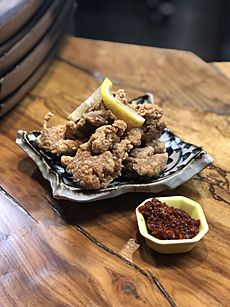Karaage facts for kids
Karaage (唐揚げ, 空揚げ, or から揚げ, [kaɾa aɡe]) is a popular Japanese cooking style. It involves deep frying different foods in oil. Most often, it's used for chicken. But you can also make karaage with other meats or fish.
To make karaage, small pieces of meat or fish are lightly coated. They might use flour, potato starch, or corn starch. Before coating, the food is often marinated to add flavor. This cooking method is different from tempura. Tempura uses a batter and is not marinated. Karaage is often served by itself, with rice, or with shredded cabbage.
The Story of Karaage

Karaage became very popular in Japan around the 1920s. A restaurant called Toyoken in Beppu, Japan, helped make it famous. This cooking method became even more popular after World War II. There was a shortage of food, especially chicken, in Japan. Karaage made chicken easier to cook. It also offered a new and tasty way to enjoy it.
The idea of deep-frying with a heavy coating, like karaage, came to Japan from China. It was first used to fry tofu for vegetarian meals. What makes it special is the use of soy sauce and rice wine in the cooking process. The word "kara" in karaage used to refer to things from the Tang Dynasty in China. It meant something was of Chinese or foreign origin.
Since the 1920s, karaage has spread all over Japan. Today, when people say "karaage," they usually mean fried chicken. This is because fried chicken karaage is the most common version. You can easily find chicken karaage in convenience stores like Lawson, FamilyMart, and 7-Eleven. It's a popular fast food item. You can also find it at many food stands across Japan.
When karaage is coated with starch, it's sometimes called Tatsuta-age. Tatsuta is the name of a river, but no one is quite sure why the dish got that name. Karaage is also a favorite at Japanese festivals and food stalls. For example, the city of Oita has an annual Karaage Festival. Over 60 different shops join to offer their unique versions of this delicious Japanese dish.
-
Gobō karaage (burdock root)
Karaage in Pop Culture
Karaage is a big part of Japanese food culture. It has even appeared in TV shows and movies.
- One famous appearance was in the anime and manga series Shokugeki no Souma. This show is about a young chef who loves family restaurant food.
- Famous chef Anthony Bourdain also loved karaage. He often talked about how much he enjoyed it. He said he always stopped at Lawson to buy karaage when he visited Japan.
- The Japan Air Self-Defense Force even uses deep-fried chicken karaage as a special dish. They use it to help promote their force.
Different Kinds of Karaage
As karaage spread across Japan, different regions created their own special versions. Here are some of the most well-known:
- Zangi – This is Hokkaido's version of karaage. It's made with a special marinade. It's often served with a spicy dipping sauce.
- Tebasaki – From Nagoya, this karaage uses chicken wings with the bone still in. It's sprinkled with sesame seeds. It also has a special sauce brushed on it.
- Toriten – This version comes from Oita. The chicken is coated in wheat flour. It's often used as a topping for udon noodles.
- Chicken nanban – From Miyazaki, this karaage is dipped in sweet vinegar. It's then topped with creamy tartar sauce.
- Gurukun no kara-age – This is Okinawa's unique karaage. It uses Gurukun, which is Okinawa's official fish. It's often called a "banana fish." The whole fish is fried and served with lemon.
- Dakgangjeong – This is Korea's take on fried chicken. It's very similar to karaage. It's usually made with milk. It also has a sweet and spicy sauce. This sauce often includes soy sauce, rice wine, red chili pepper paste, and honey.
- Fugu no kara-age – This version is popular in Yamaguchi. The city of Shimonoseki is famous for fugu (pufferfish). Many restaurants there serve fugu karaage. The flesh, organs, and bones of the pufferfish are deep-fried.
See also
 In Spanish: Karaage para niños
In Spanish: Karaage para niños







